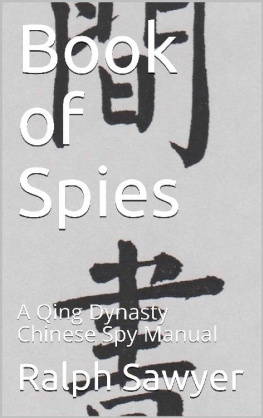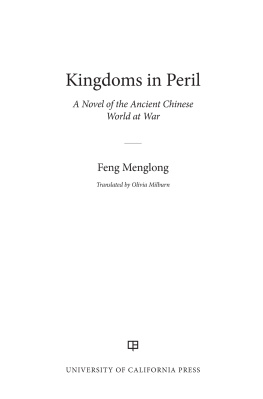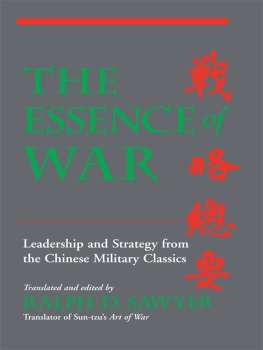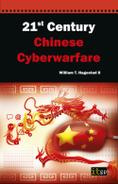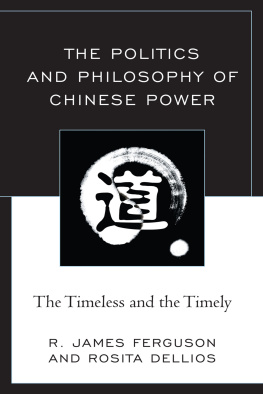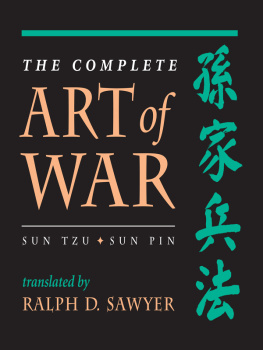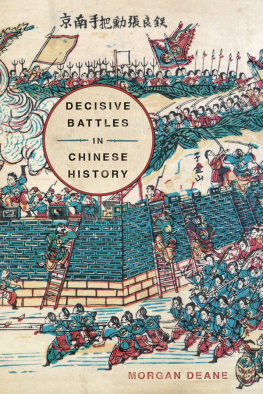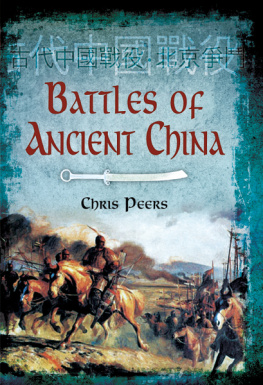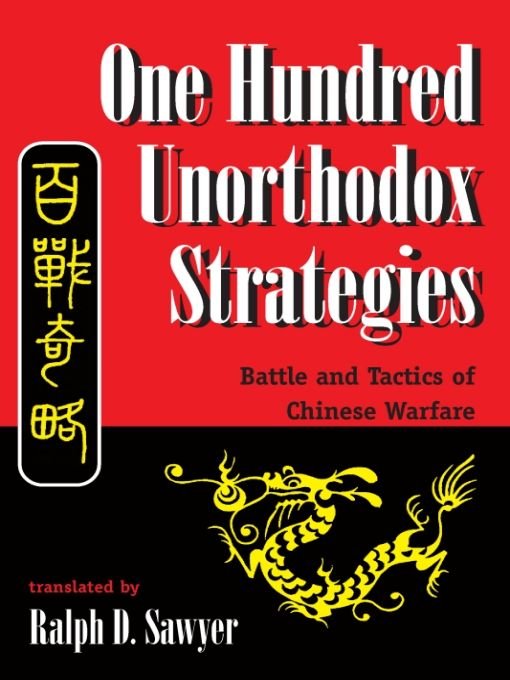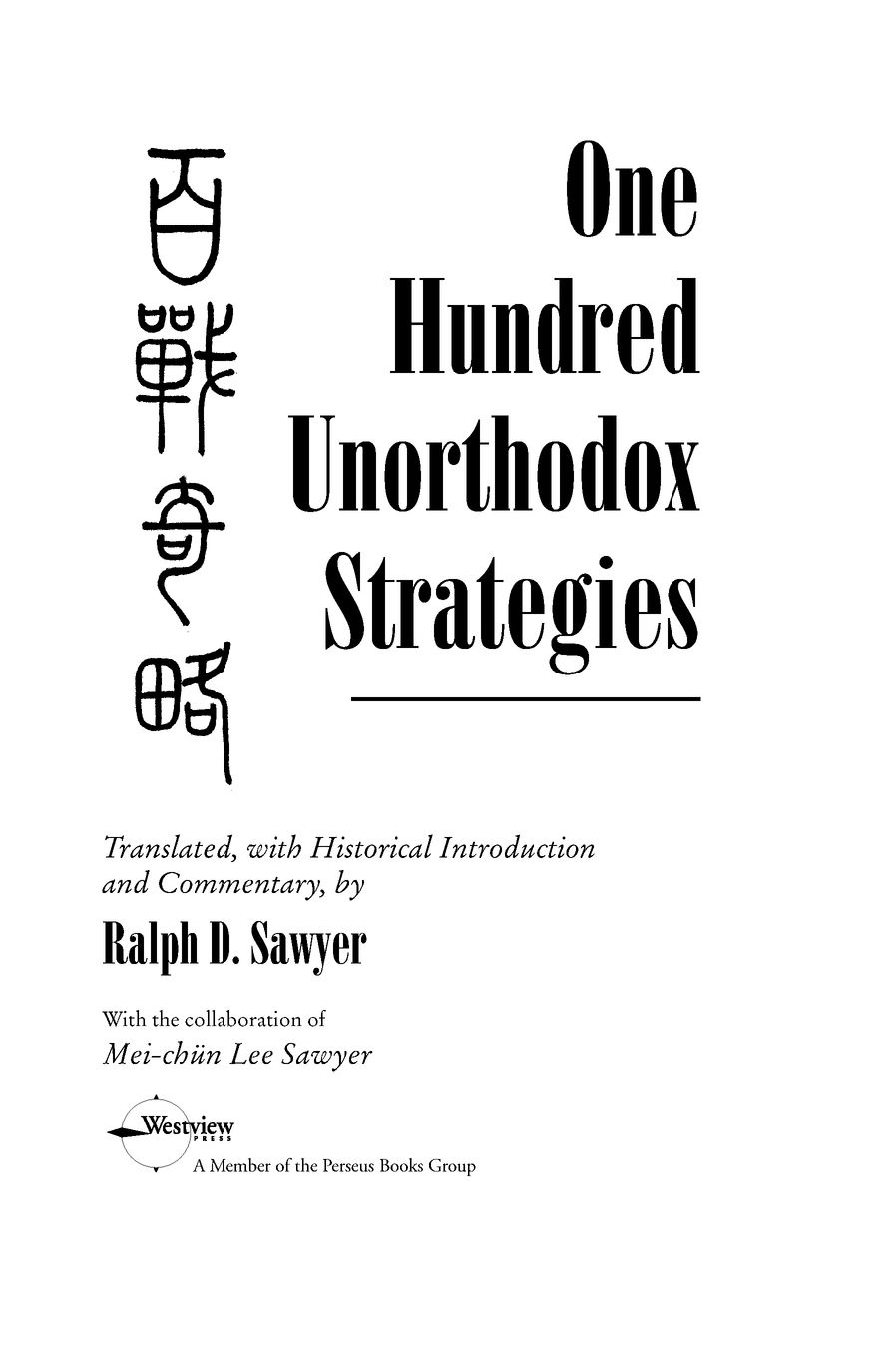Table of Contents
Preface
The work originally known as One Hundred Unorthodox StrategiesPaichan Chi-lehis a veritable compendium of tactical principles and historic battles, the latter being chosen to illustrate the individual lessons unfolded by the tactical discussions. Traditionally identified as Liu Po-wen, the books author remains unknown but likely held a bureaucratic military position of some rank late in the Southern Sung dynasty and possibly completed the work early in the period of Mongol domination, as evinced by his grasp of the political factors affecting military affairs and his detailed knowledge of both military texts and historical writings. The Unorthodox Strategies thus provides a vibrant, systematic introduction not only to Chinese military thought but also to much of its military history. Moreover, while many prominent battles are recounted, others are rescued from obscurity, providing further evidence of the authors extensive knowledge and thoroughly analytic approach. (A few, however, prove somewhat puzzling because the critical factors presumably operative in a particular conflicts outcome appear less decisive than might have been expected.) The authors ability to discern abstract military principles within concrete contexts thus furnishes innumerable insights into the abstruse, often enigmatic Chinese military writings and an opportunity to study how tactical principles were actually employed by a hundred historical commanders over two thousand years.
As with our previous works, this book is intended for a general audience rather than just sinologists, military historians, or other specialists. Moreover, since the chapters are self-contained and self-explanatory, forming a tactical handbook for thoughtful studywhether centered on its original military intent or for more widespread application, including business, human relations, or the world at largewe have adopted a somewhat broader approach to its translation and presentation than previously. The introduction and appendices provide but a brief overview of the salient characteristics of Chinese warfare in the vast historic period under discussion and short summaries of the basic military writings frequently cited. No attempt has been made to fully discuss either of these, as they are covered in our other works, such as the Seven Military Classics of Ancient China, the Military Methods, and our forthcoming History of Warfare in China. Furthermore, while providing a few notes on the military contents for orientation, we have not undertaken a systematic, analytical overview, because the nature of the Unorthodox Strategies is inherently discrete and best explicated in concrete fashion in response to the numerous principles presented in the individual chapters. This is not to deny the existence of a systematic vision, one that might be said to underlie and characterize Chinese military sciencebased, for example, on the principles of maneuver warfare with all their ramifications, such as presently embodied in the U.S. Marine Corps Warfighting manualsbut in constructing such a synthesis the main thrust of the Unorthodox Strategies (to be flexible, variable, and formless) might also be overlooked. In fact, one of the critical lessons that must be painfully learned is that no single principle is ever applicable in all situations. Thus, while speed and swiftness are generally stressed, in some circumstances speed will not only exhaust ones forces but also uselessly throw them against overwhelming foes. Therefore speed and initiative are to be balanced with temporizing and defensive measures whose appropriateness (or domain of applicability) must be determined with respect to fixed parameters that characterize commonly recurring situational categories.
Insofar as the original texts are readily accessible and variations among the editions minimal, we have neither provided footnotes for our choice of one or another rendition nor systematically corrected the historical illustrations by comparative recourse to the original passages in the Twenty-five Histories and other sources. Rather, we have treated the book as a self-contained work, as virtually every Chinese reader has over the past few centuries. Scholars with competence in classical Chinese will readily note where alternative readings were selected or an explanatory phrase added, but may also wish to consult Chang Wen-tsais excellent Pai-chan chi-fa chien-shuo (Chieh-fang-chn chu-pan-she, Peking, 1987), which offers a carefully corrected text based on full research into the original passages and whose thoughtful conclusions regarding the texts authorship and date we generally follow. (Chang also points out that the book was originally called the Pai-chan Chi-fa and only acquired its present name of Pai-chan Chi-leh toward the middle of the Ching period.)
In presenting this material there was a great temptation to extensively discuss the individual battles, setting them within their historical contexts and exploring the tactical implications. However, this would not only result in an unwieldy book, but further distract from the authors original purposeto illustrate his tactical lessons with concrete examples rather than analyze concrete battles in terms of tactical principles. Insofar as the historical figures, while not unimportant, are merely actors in such illustrations, we have opted neither to explore nor expand them in cumbersome footnotes. Rather, our aim has been to produce a work equally accessible to those interested in military history, Asian history, and tactical thought in general, whatever their proposed domain of applicability. However, in the traditional Chinese manner we have appended brief observations to each chapter, sometimes commenting on the historical context or importance of the battles themselves but generally explicating the tactical principles with reference to the heritage of Chinese military thought as embodied by the Seven Military Classics and Sun Pins Military Methods. We have emphasized concrete comparisons rather than general principles and frequently include divergent or alternative views. While the Unorthodox Strategies is therefore a self-contained, fully independent volume, it may also be viewed as a companion to our previous works, the Seven Military Classics and the Military Methods.
Apart from the abstract debt we owe to the historical commentators whose labors have illuminated Chinas innumerable texts, we would like to again acknowledge Zhao Yongs ongoing assistance in locating and obtaining obscure textual materials. In addition, we have benefited greatly from the wisdom and insightful comments of Peter Kracht, senior editor, as well as the expertise and commitment of the staff at Westview Press in making this book possible. As always, our thanks to Max Gartenberg for his generous efforts and to Lee Ting-rong, who has once again honored the work with his calligraphy
Ralph D. Sawyer
A Note on Pronunciation
As our views remain unchanged, we repeat our comments from our previous works: Unfortunately, neither of the two commonly employed orthographies makes the pronunciation of romanized Chinese characters easy. Each system has its stumbling blocks, and we remain unconvinced that the Pinyin qi is inherently more comprehensible to unpracticed readers than the Wade-Giles chi, although it is certainly no less comprehensible than


